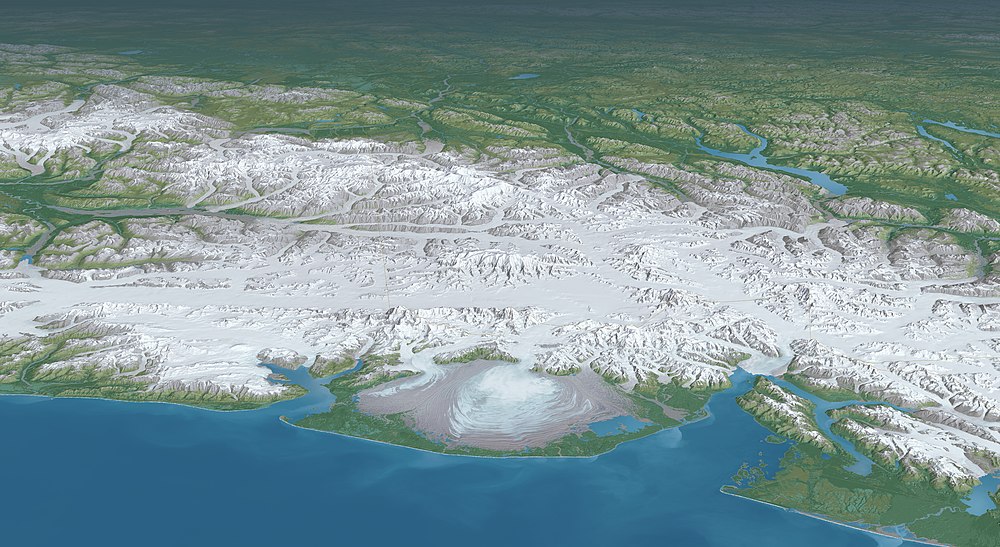User:Penitentes/Tyndall Glacier (Alaska)
| This is not a Wikipedia article: It is an individual user's work-in-progress page, and may be incomplete and/or unreliable. For guidance on developing this draft, see Wikipedia:So you made a userspace draft. Find sources: Google (books · news · scholar · free images · WP refs) · FENS · JSTOR · TWL |
| Tyndall Glacier | |
|---|---|
Valley glacier/Tidewater glacier | |
| Location | Alaska |
| Coordinates | 60°11′46.17″N 141°8′35.69″W / 60.1961583°N 141.1432472°W |
| Length | 19 kilometers |
| Terminus | Taan Fjord |
| Status | Receding |
Tyndall Glacier is a valley/tidewater glacier in the U.S. state of Alaska. The glacier lies immediately west of 141° West longitude, within the boundaries of the Wrangell–Saint Elias Wilderness, itself part of Wrangell-St. Elias National Park & Preserve, in the borough of Yakutat.
Named for John Tyndall (a 19th century Irish physicist, natural philosopher, and glaciologist),Tyndall Glacier originates in the basin formed by the southwestern face of Mount Saint Elias (the second-tallest mountain in the United States and the fourth-tallest in North America), as well as Mount Huxley, The Hump, and Haydon Peak in the Saint Elias Mountains. From there it extends 19 kilometers, trending southwest, where it terminates in Taan Fjord, an arm of Icy Bay.[1][2] It, together with the Yahtse and Guyot glaciers, once occupied the entirety of Icy Bay; as the glaciers have retreated the bay has opened up.
Tyndall Glacier is sometimes used as a landing area for bush planes by parties seeking to climb Mount Saint Elias, as it was during the first winter ascent of Mount Saint Elias.[3]
History
Tyndall Glacier first started to advance out of Taan Fjord around 1400 A.D.,[4] and reached its Little Ice Age maximum length at the mouth of Icy Bay at some point prior to 1794, when George Vancouver mapped the ice extending out from Icy Bay. Tyndall Glacier then began to retreat in 1905. Between 1938 and 1961, Tyndall Glacier's terminus retreated approximately 3 kilometers, until it separated from Guyot Glacier in Icy Bay around 1961.[4] After that, the Tyndall Glacier then retreated approximately another 10.5 miles, or 17 kilometers, between 1961 and 1991.[5][6]
Since 1991, the glacier's retreat has stabilized, with a terminus at a "shallow bedrock constriction at the head of the fjord," called Hoof Hill.[7][4] According to scientific study, "In just 40 years of retreat, approximately half of the total volume of the glacier in 1961 has been lost (∼3.19 × 1010 m3), and the glacier thickness has decreased over ∼300 m at the present glacier terminus".[4]
Bradford Washburn noted in 1992 that the glacier's retreat has meant that the summit of Mount Saint Elias is only twelve miles from tidewater, exacerbating the peak's immense vertical relief.[8]
2015 landslide and megatsunami
Tyndall Glacier and Icy Bay are notable for being the site of an enormous landslide and subsequent megatsunami in 2015, which is described in the article for Icy Bay.
Gallery
https://www.usgs.gov/media/images/tyndall-glacier-taan-fiord-alaska
See also
- piedmont glacierand the largest such in the world)
- List of glaciers
References
- ^ "Geographic Names Information System". edits.nationalmap.gov. Retrieved 2022-07-28.
- ISSN 0260-3055.
- ^ "Mount Saint Elias, First Winter Ascent". Climbs And Expeditions. American Alpine Journal. American Alpine Club. 1997. Retrieved 2022-07-28.
- ^ ISSN 0148-0227.
- ISSN 0190-8286. Retrieved 2022-07-28.
- ^ Pappas, Stephanie (2018-09-08). "Warnings Abounded Before Massive Alaska Landslide and Tsunami". Live Science. Retrieved 2022-07-28.
- ISSN 2045-2322.
- ^ "AAC Publications - North America, United States, Alaska, Mount St. Elias as a Coastal Peak". publications.americanalpineclub.org. Retrieved 2022-07-28.
External links
Category:Glaciers of Alaska:
Category:Glaciers of Yakutat City and Borough, Alaska:


